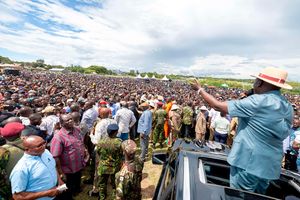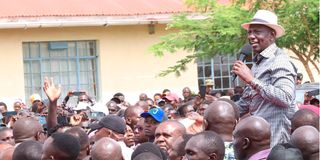
President William Ruto addresses residents of Suna West in Migori County after he commissioned the sub county office on May 4, 2025.
A video of President William Ruto struggling to keep away a “flying shoe” from hitting his face during a rally in Kehancha, Migori County on Sunday rekindled memories of how key political leaders have had their security breached in public.
Despite being the most protected Kenyan, the Head of State’s security was caught napping in a moment of security scare that in other circumstances would have been catastrophic.
The lapse brings to the fore how high-ranking politicians in the country have been left exposed in rowdy rallies as they chase political optics.
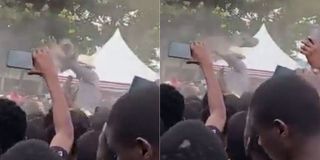
A shoe could be seen flying from the crowd, hitting President Ruto who was mid-speech.
Politicians often want to be closer to the crowd but this exposes them to danger as controlling a political gathering has over the years proven to be a security nightmare for their security detail.
Although another angle of the viral five-second video incident showed that the shoe might not have been hurled at the President, as it appears to have been slapped out of the hands of the owner towards the direction of Dr Ruto, the happening is a chilling reminder of how vulnerable leaders are while addressing such large crowds.
The Commander-in-Chief had to take it upon himself to prevent the “croc shoe” from hitting his face through a last-ditch swing of his left hand while the other hand held the microphone with his security detail only reactive rather than proactive.
The incident briefly disrupted the event as security officers tasked with protecting the Head of State reactively rushed to the stage to protect the Kenya Kwanza Alliance leader as others combed through the crowd in search of the “suspect”.
Even before the incident, the crowd in Kuria West had become difficult to manage as they surged towards the podium where the President was addressing from.
Although Migori Woman Representative Fatuma Mohamed tried to play down the occurrence by arguing that the residents were just eager to see their president and wanted to get closer to him, the damage had already been done.
“Let the media not report their own version of events. What happened is that they wanted to greet the President, but they couldn’t reach him,” said Ms Mohamed.
Reports indicate that police officers in Kuria West have arrested three individuals suspected to have been involved in the Sunday incident as investigations are ongoing and that more suspects are being pursued.
The incident mirrors the widely publicised incident from December 14, 2008, when then-US President George W. Bush was narrowly missed with a shoe thrown by an Iraqi journalist, Muntadhar al-Zaidi, during a press conference in Baghdad.
Before being tackled and dragged away by security officers, the journalist somehow managed to hurl another shoe at the outgoing president, who also missed. Bush later made light of the incident, joking, “All I can report is it’s a size 10.”
Nonetheless, that was not the first time highly-protected top political leaders in the country have found themselves at the crosshairs in political rallies.
In September 2014, former President Uhuru Kenyatta found himself in an almost similar incident in the same county when a shoe was hurled towards the dais where he was although it still remains unclear who the target was.
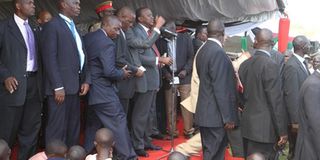
Security officers shield President Uhuru Kenyatta when he rose to address a meeting in Migori that turned chaotic after youths started throwing shoes and shouting party slogans on September 8, 2014. The President is right to decry the massive cost of hiring buses to transport passengers from planes to the arrival terminal. PHOTO | CORRESPONDENT |
The incident at Migori Primary School grounds forced the presidential security team to throw a security cordon around the tent where the Head of State and other dignitaries sat.
Mr Kenyatta was at the county to launch an anti-malaria campaign when he was caught up in the local political supremacy battles.
The agitated crowd, chanting ODM slogans, became rowdy, hurling even plastic chairs at the presidential dais as former Migori Governor Okoth Obado, who was from a rival party, prepared to welcome the President.
The same month, former prime minister Raila Odinga was attacked by an elderly man during an Okoa Kenya public rally in Kinango, Kwale County.
The man, later identified as a farm hand by the name Lengo Karisa Mdzomba, unleashed some quick strikes with his walking stick before he was wrestled to the ground by Mr Odinga’s security detail.
The man emerged from the crowd and attacked Mr Odinga and the-then Kwale Governor Salim Mvurya (now Sports Cabinet Secretary) using a walking stick.
The man hit the ODM party leader and Mr Mvurya twice each on the back moments after the leaders had joined a dancing troupe for the traditional sengenya dance, a security lapse that exposed the underbelly of security details of top leaders in the country.
Mr Richard Tutah, a security expert, says that there is no tamperproof security system in the world that cannot be breached, citing the example of ex-US President Bush’s security which was breached despite being in a controlled environment. However, he argues that overrunning such a system is the problem.
He explains that a good security system must have the capability to survive a first strike and turn the tables.
On the Migori incident, Mr Tutah argues that there wasn’t a hostile environment to make the security around the President more alert.
“When I analysed the clip, the guy had no wrong intention. It is just that some people want to take it out of proportion. You realise that the one who lifted the shoe is not the guy who hit it. Anyone who had an intention would have tried a second throw,” avers Mr Tutah.
“Assume the guy threw the first shoe, did he have the capability of throwing the second one? Then you can say whether the security arrangement around the President was bad,” he adds.
However, they also had to balance between the security of the principal and the principal discharging his core mandate.
“At the end of the day, the president must discharge his duty unless you want the president to be walking around in a bunker and again you will say he is paranoid against his electorate.”
But Byron Adera, an international security expert, consultant and trainer, seems to hold a different view, saying the incident should not be seen casually as an isolated incident as it has far-reaching national security implications beyond the casual look of it.
He argues that beyond saying it was just a shoe and it graced the President’s hand, it must be understood that the risk-threat assessment around such a high-value target is not only a threat to their lives but also carries reputational damage to the protection around him so much so that anybody out there watching the same thing and is a formidable force can be encouraged to compromise the life of the president.
“Just the perception that it is easy to breach the security bubble around the president and get to him is already too damaging. As much as he is a politician and he trusts the public, his security must be taken care of as seriously and that bubble must not be broken at any time,” says the ex-Kenya Special Forces officer.
Kenyan presidents, since the promulgation of the 2010 Constitution, have enjoyed the protection by a special unit – the Presidential Escort Unit (PEU), which came into force in 2011.
The unit has highly-trained officers mainly drawn from the elite Recce Company and the General Service Unit (GSU) with a primary responsibility of protecting the president and the deputy president together with their families.
Apart from the highly trained firearm handlers, the unit also comprises defensive drivers, riders, snipers, combat leads, explosives experts and intelligence officers.
Together with his family, the President has about 200 security guards drawn from the GSU. PEU is a fully-fledged team that can handle the movement of the President and his family at any time.
The Unit, however, usually gets the help of the local police whenever the President visits various parts of the country.
PEU has 200 officers attached to the President and another 45 attached to the Deputy President, in the current Kenyan scenario.
In June last year, long serving head of security operations in the office of the President Noah Maiyo was named the new PEU Commandant taking over from William Yiampoy.
Mr Maiyo, who is also an assistant Inspector General, served as the head of operations at PEU for two years. He was in a similar position at the Office of the Deputy President for a decade.
An expert in VIP protection, having served in the Presidential Escort for more than 30 years, the new commandant served in the GSU and Recce.
The two incidents involving President Ruto and his predecessor add to the troubling trend of presidential security breaches in the country.
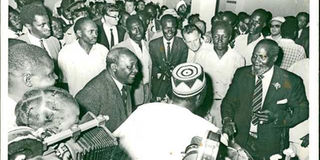
KPU leader Jaramogi Oginga Odinga (with cap) in an exchange with President Jomo Kenyatta in October 25, 1969, shortly before Mzee's bodyguards opened fire and killed about 50 people in Kisumu.
In October 25, 1969, a ceremony to open a public hospital in Kisumu turned into a massacre when stone-throwing youth chanting Kenya People’s Union slogans forced the late President Mzee Jomo Kenyatta to cut short his speech after a bitter exchange with his former Vice-President Oginga Odinga.
Kisumu riots as rock-throwing mobs forced his father Jomo Kenyatta to cut short his tour of then Nyanza Province.
It was said that someone from the crowd hurled a stone at the main dais as the-then vice president the late Daniel Arap Moi was planning to introduce Mzee Kenyatta to the crowd.

Police disperse crowds in Kisumu by shooting indiscriminately during a visit by Jomo Kenyatta on October 25, 1969. PHOTO | FILE | NATION MEDIA GROUP
President Kenyatta’s call to the unruly crowd to calm down and be orderly fell on deaf ears as more stones were lobbed at the presidential dais. Soon chairs were flying everywhere as the chaotic situation prevailed.
The presidential bodyguards opened fire to scare off the surging crowds as they rushed to ensure Mzee’s safety.
It is reported that one of the presidential guards, a Mr Gicheru, a hefty bouncer, hoisted Mzee Kenyatta on his shoulders and dashed off to the presidential limousine.
The aftermath – many people were shot dead, and many others died from the ensuing stampede, especially children, following the gunfire while scores were left injured.

